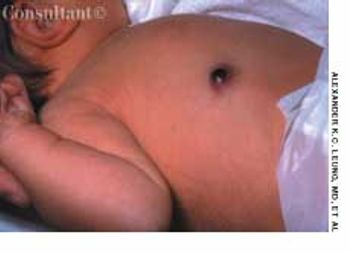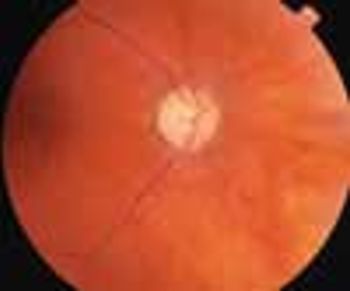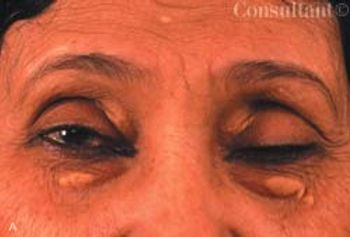
A male infant was born to a 29-year-old woman (gravida 3, para 2), following an uncomplicated pregnancy and normal vaginal delivery. At birth, a brownish 1-cm nodule was noted on the right side of the upper abdomen. The infant was otherwise healthy.

A male infant was born to a 29-year-old woman (gravida 3, para 2), following an uncomplicated pregnancy and normal vaginal delivery. At birth, a brownish 1-cm nodule was noted on the right side of the upper abdomen. The infant was otherwise healthy.

Until recently, practitioners focused on the timing of initiation of renal replacement therapy (dialysis) and transplantation once advanced kidney disease had developed. However, a new CKD classification system now provides an action plan for the earlier stages of the disease.

ABSTRACT: The principal dietary strategy to reduce low-density lipoprotein cholesterol (LDL-C) levels is to decrease the amount of saturated fat and cholesterol in the diet. Consumption of soluble fibers, plant sterol and stanol esters, nuts, and soy protein further reduces LDL-C levels. Soluble fibers, such as psyllium, lower LDL-C levels by increasing bile acid loss, interrupting enterohepatic circulation of cholesterol, and reducing hepatic cholesterol delivery. Plant stanol and sterol esters, which are added to margarine, mayonnaise, and olive oil, are effective LDL-C–lowering agents. Nuts such as almonds and walnuts reduce LDL-C levels and have been associated with a 30% to 50% reduction in coronary heart disease risk. A diet that combines the above elements, plus soy protein, reduces LDL-C levels as much as starting doses of statins.

Ezetimibe/simvastatin (Vytorin)recently became available for thetreatment of high LDL cholesterollevels, as adjunctive therapy to dietarymodification, in patients withprimary hypercholesterolemia ormixed hyperlipidemia. This drug,from Merck/Schering-Plough Pharmaceuticals,inhibits the productionof cholesterol in the liver and blocksthe absorption of cholesterol in theGI tract, including cholesterol obtainedfrom food.

ABSTRACT: High-sensitivity C-reactive protein (hs-CRP), a marker of low-grade vascular inflammation, reflects baseline inflammatory predilection-a key factor in the genesis and rupture of atheromatous plaque. Measurement of hs-CRP is recommended in persons who have an intermediate (10% to 20%) 10-year risk of coronary artery disease; a level above 3 mg/dL indicates higher cardiovascular risk. Although dietary therapy and statins may lower hs-CRP levels, such reductions have not been shown to prevent cardiovascular events or death. Elevated homocysteine levels have been associated with an increased risk of cardiovascular disease. Consider screening in patients with a personal or family history of cardiovascular disease who do not have well- established risk factors. Supplementation with folic acid and vitamin B12 reduces homocysteine levels by about 30%. Elevated fibrinogen levels have been associated with ischemic heart disease and stroke; however, fibrinogen-lowering therapy has not led to better outcomes than standard treatment regimens.

Despite the manydouble-blind,placebo-controlledtrials thathave demonstratedthe efficacy of statins inreducing the risk of cardiovascularevents, a largenumber of patients who aretreated with these drugsstill experience suchevents. This may be becausepatients who requireintensive lipid lowering arenot receiving adequatedosages of statins.

ABSTRACT: Unlike revascularization procedures-which do not uniformly reduce future vascular events because they do not substantively alter the underlying atherosclerotic process-optimal lipid-lowering therapy can modify atherosclerotic risk. Recent trial data suggest that coronary plaque progression is delayed and the incidence of ischemic events is reduced when low-density lipoprotein cholesterol (LDL-C) levels are lowered to approximately 70 mg/dL in high-risk patients. Aggressive lipid reduction to achieve this goal is now a therapeutic option presented in the latest update to the National Cholesterol Education Program guidelines. Dietary modification remains essential for patients with coronary heart disease and should be initiated concurrently with lipid-lowering medications. Compared with other lipid-modifying agents, statins provide the most robust reductions in LDL-C levels. A statin may be combined with a bile acid sequestrant, niacin, a fibrate, or ezetimibe for more aggressive treatment.

ABSTRACT: To assess a child for overweight, begin by calculating his or her body mass index (BMI). Note that BMI is used differently in children than it is in adults. A child's BMI is plotted on a growth curve that reflects that child's age and gender. This yields a value-BMI-for-age-that provides a consistent measure across age groups. Children whose BMI-for-age is between 85% and 95% are at risk for becoming overweight. Any child whose BMI-for-age is 95% or more is considered overweight. The 2 main factors associated with overweight in children are poor eating habits and decreased physical activity. Recommend that children have at least 5 servings of fruits and vegetables a day. Children should engage in moderate physical activity for at least 60 minutes on most days of the week, and TV viewing and computer activities should be limited to no more than 2 hours a day.

ABSTRACT: Restriction of fluid and salt intake is essential in patients with edema. Bed rest and supportive stockings are also helpful. However, diuretics are usually the mainstay of therapy. The effect of thiazide diuretics is relatively mild; they may be adequate in patients with cirrhosis but are ineffective in those with congestive heart failure (CHF) or nephrotic syndrome. Loop-acting diuretics can induce massive natriuresis and diuresis. Intravenous loop diuretics are preferred to oral agents for the relief of pulmonary edema. Acetazolamide, a carbonic anhydrase inhibitor, is commonly used in patients with glaucoma and is also recommended for those with CHF accompanied by metabolic alkalosis. Combination therapy is recommended for patients with refractory edema and normal or somewhat impaired renal function. The adverse effects of thiazide and loop-acting diuretics include renal insufficiency, hyponatremia, hypochloremia, hypokalemia, hypomagnesemia, metabolic alkalosis, hyperglycemia, and hyperlipidemia. These effects are typically reversed when the dosage is reduced or therapy is discontinued. Potassium sparing diuretics can cause life-threatening hyperkalemia.

Coronary heart disease (CHD) is a significant cause of death in patients with a history of isch- emic stroke or transient ischemic attack (TIA). These patients may have no symptoms of CHD, yet they often have cardiac risk factors.

ABSTRACT: Guidelines for the management of patients with unstable angina and non-ST-segment elevation myocardial infarction have been updated following results from pivotal controlled trials. The new American College of Cardiology/American Heart Association guidelines stress risk factor modification and long-term management. Medications that have been shown to reduce the incidence of future cardiovascular events in patients with acute coronary syndromes include antiplatelet agents, statins, ß-blockers, and angiotensin-converting enzyme inhibitors. Other long-term management strategies include smoking cessation, achievement and maintenance of optimal weight, daily exercise, appropriate diet, and control of hypertension and diabetes.

ABSTRACT: The metabolic syndrome, which presents as a cluster of atherogenic traits, confers an increased risk of coronary heart disease (CHD) that may be greater than the sum of the risks associated with the individual components. The principal components of the syndrome are abdominal obesity, elevated triglyceride level, low high-density lipoprotein cholesterol level, elevated blood pressure, and elevated fasting glucose. The presence of 3 of the 5 characteristics establishes the diagnosis. First-line therapy for the metabolic syndrome consists of lifestyle modification measures, such as weight reduction and physical activity; however, pharmacologic treatment may be necessary. Statin therapy decreases the elevated levels of low-density lipoprotein cholesterol and triglycerides characteristic of the metabolic syndrome. Control of nonlipid CHD risk factors, such as hypertension and diabetes, is also critical.

Painful blue toes developed in a 72-year-old woman with coronary artery andperipheral vascular disease after she underwent angiography.

ABSTRACT: Before a diagnosis of subclinical hypothyroidism is made, other causes of elevated thyroid-stimulating hormone (TSH), such as recovery from a serious acute illness, must be ruled out. Diagnosis is based on at least 2 assays performed over a period of several weeks. If the screening TSH levels are abnormal, measurement of serum free thyroxine is needed to confirm the diagnosis. Although patients who have TSH levels in the upper limit of the traditional normal range may be at higher risk for progression to hypothyroidism, no evidence exists for adverse health consequences. For patients with serum TSH levels in the range of 5.1 to 10 mIU/L, consider such factors as age, comorbidities, symptoms of hypothyroidism, pregnancy or anticipation of pregnancy, and the presence of goiter or antithyroid antibodies in the decision to treat. Thyroxine therapy is recommended for patients with serum TSH levels above 10 mIU/L.

Every minute, an American woman dies of cardiovascular disease (CVD), the leading cause of death among women in the United States. Each year, more than half a million women die of cardiovascular causes, including 250,000 of coronary heart disease.Despite the prominent reduction in cardiovascular mortality in the United States among men, mortality has not decreased recently among women. Since 1984, CVD has killed more American women than men every year.1,2

A methodical approach to diagnosis usually reveals the cause of fever. In patients with simple fever, a careful history taking and physical examination combined with basic laboratory and imaging studies (complete blood cell count with differential, urinalysis, and possibly a chest film and blood cultures) usually yield the diagnosis. In patients with prolonged fever whose cause remains undiagnosed after extensive examination (fever of unknown origin), repeat the history taking and physical examination; also order routine laboratory studies, an HIV test, a tuberculin skin test, 3 sets of blood cultures, and chest films. In addition, abdominal CT scanning is often useful. Further testing at this point may include fluorodeoxyglucose positron emission tomography, technetium-tagged white blood cell scanning, transesophageal echocardiography, liver biopsy, bone marrow examination, and/or temporal artery biopsy. Exploratory laparotomy is rarely indicated.

An 86-year-old woman had noted intermittent, transient “shading” and “hazing” of the vision in her right eye. Her best corrected vision in that eye was 20/20. She had pseudophakia from past cataract surgery.

An 87-year-old woman complained ofseeing a red tinge on the wallpaper inher house through her right eye. Thepatient had mild memory loss andmoderate hypertension, for whichshe took atenolol. She had quit smokingcigarettes many years earlier.

Signs and symptoms that strongly suggest peripheral arterial occlusive disease include diminished or absent pedal pulses, a unilaterally cool limb, and atrophic skin that is shiny and hairless. An ankle-brachial index of less than 0.5 suggests multisegment disease. Management goals are to decrease functional impairment, treat underlying atherosclerosis, and control risk factors. Smoking cessation is imperative. A graduated walking program is a mainstay of treatment and is associated with greater improvement in pain-free walking than is drug therapy. Surgery and percutaneous intervention are generally reserved for patients with lifestyle-limiting claudication, ischemic pain at rest, tissue loss, or gangrene.

A 12-year-old African American girl comes to youroffice for a well-child checkup. She is tall for herage (height above the 95th percentile) and obese(body mass index [BMI] above the 95th percentile).Physical examination reveals acanthosisnigricans on her neck, axilla, and upper abdominalregion (Figure) and a vaginal yeast infection.Routine urinalysis reveals a glucose level ofgreater than 1000 mg/dL, with negative proteinand ketones. A random blood glucose test, obtainedbecause of the glucosuria, is 249 mg/dL.

Persons with a systolic blood pressure (BP) of 120 to 139 mm Hg or a diastolic BP of 80 to 89 mm Hg are now considered, according to the latest Joint National Committee (JNC) report on hypertension.

ABSTRACT: Results of the Heart Protection Study (HPS)-the largest prospective statin trial to date-have confirmed that the cardioprotective effects of statin therapy extend to high-risk patients regardless of age, sex, or baseline serum cholesterol levels. Yet despite compelling efficacy data, statins are not prescribed as often or as aggressively as they should be, even among patients at high risk for coronary heart disease (CHD). Recent studies have shown a significant reduction in the risk of CHD among patients 65 years and older with statin treatment. These agents are also recommended as first-line therapy for prevention of CHD in postmenopausal women. Statins appear to be cardioprotective even in patients with average baseline serum total cholesterol levels.

Persons with severe mental illnesses (SMI), such as schizophrenia, are at increased risk for comorbid conditions- including type 2 diabetes-independent of therapy. SMI sufferers especially at risk for type 2 diabetes are women, African Americans, and persons older than 45 years. Among the possible causes of increased susceptibility to type 2 diabetes are such schizophrenia-associated conditions as impaired glucose tolerance, overweight, obesity, inadequate nutrition, lack of exercise, and inadequate self-care. Other obstacles to good health care among patients with schizophrenia include impaired communication ability, denial of illness, social withdrawal, and undertreatment because of comorbid conditions. Different antipsychotic medications may also contribute to preexisting insulin resistance or glucose intolerance. Clinicians can optimize care by understanding the most significant barriers for each patient and incorporating this knowledge into an active treatment plan.

A 59-year-old woman presented for a routine physical examination. She had no physical complaints and took no medications. During the physical examination, bilateral, flat, slightly elevated, yellowish cutaneous lesions were noted above and below the skin folds of the patient's eyelids.

A 34-year-old woman complains of headaches that interfere with work. Her first headache episode, approximately 6 yearsearlier, was relatively mild. Initially, she experienced attacks only once every 3 to 4 months and managed them effectivelywith over-the-counter (OTC) agents. However, in the last 6 months the attacks have become more frequent-they occur atleast twice a month-and are so severe that she misses work.